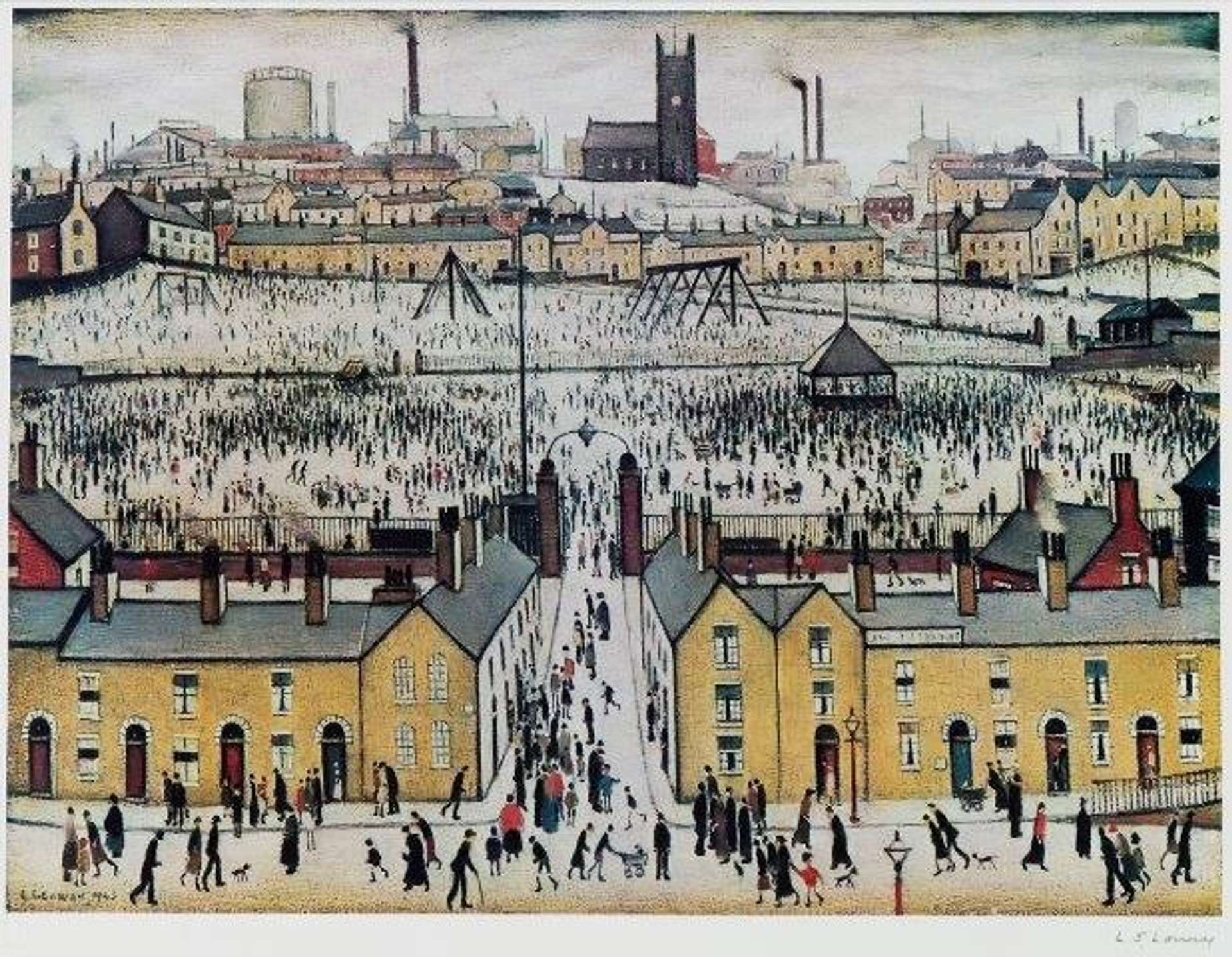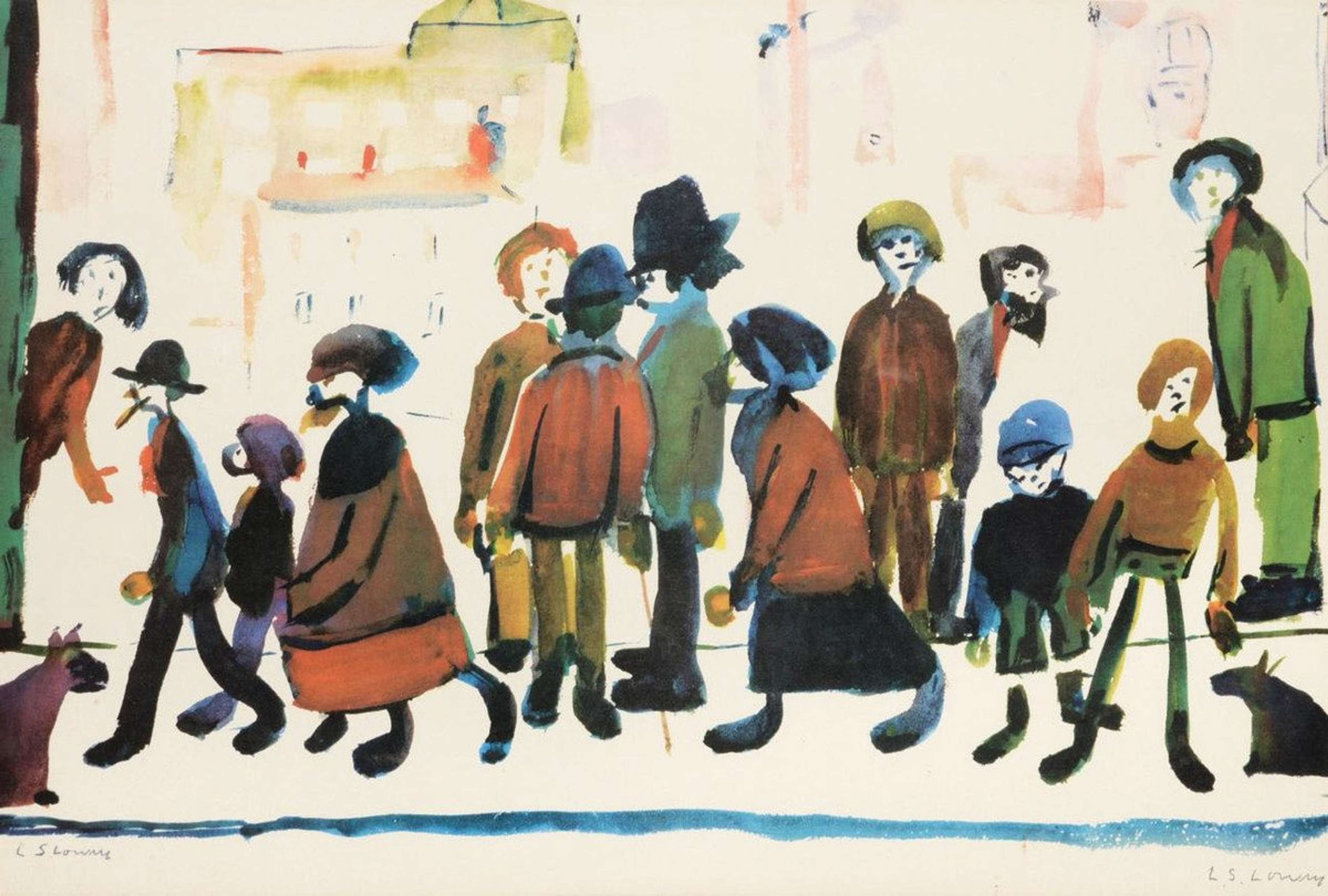L. S. Lowry and the Industrial North

 Mill Scene © L. S. Lowry 1959
Mill Scene © L. S. Lowry 1959
L S Lowry
73 works
L. S. Lowry was a renowned painter known for his depictions of working-class life in the industrial north. His iconic matchstick men have become synonymous with a bygone era, capturing the essence of a past world where factories and mills dominated the skyline.
Who was L.S. Lowry?
Born Laurence Stephen Lowry in 1887 in Manchester, Lowry was a seminal British artist whose work primarily focused on the industrial landscapes and the working-class communities of Northern England. A lifelong resident of Manchester, the city's factories, mills and smoggy skies were the backdrop of his life and became the subjects that dominated his art. The regional influence was not merely geographical, but also deeply emotional and thematic, shaping his view of humanity within the framework of industrialisation and societal changes.
Lowry's upbringing and personal experiences further influenced his artistic endeavours. He trained at the Manchester School of Art and later at the Royal Technical College, Salford, but largely considered himself to be a self-taught artist. He held a day job as a rent collector, which gave him a grassroots exposure to the living conditions of the working-class communities he depicted in his art. His somewhat isolated personal life, marked by a complex relationship with his mother, may have further deepened the sense of melancholy that pervades his work.
Lowry's work gained significant recognition during his lifetime, and his unique style has since become iconic in the realm of British art. He rejected five honours during his life, including a knighthood, as he was a modest man who sought to distance himself from the establishment. His paintings have been exhibited globally, from prestigious museums to galleries, and continue to attract scholarly attention. They are considered invaluable social documents as much as artistic masterpieces, offering an unflinching look at a critical era in British history.
Lowry passed away on February 23, 1976, in Glossop, Derbyshire, England, just weeks before a retrospective exhibition in his honour was set to open at the Royal Academy of Arts.
Depicting Working-Class Life: Lowry’s Matchstick Men
Lowry's artistic oeuvre serves as a compelling lens through which to view working-class life during England's industrial period. His work has become known for his signature "matchstick men" figures, simple yet evocative, that have become iconic symbols representing the daily tribulations of ordinary people in this transformative era. These elongated, faceless characters often populate somber industrial landscapes, embodying the anonymity and dehumanisation experienced by many in a rapidly mechanising society. These figures often appear small when set against the larger industrial landscapes, reinforcing their insignificance in the grand scheme of industrial life. One of the most striking aspects of Lowry's matchstick men is their anonymity. They lack individualistic features that would make them distinct or recognisable, emphasising the idea that they stand for the collective rather than the individual.
Lowry's colour choices further reinforce the mood. His palette, dominated by dark colours and shades of grey, creates an atmosphere of bleakness and monotony, reflecting the hard conditions of working-class life at the time. The skies in his paintings are frequently overcast, and the land is often devoid of greenery—details that capture the grim reality of polluted, industrialised cities. The scarcity of joyful or vibrant elements makes the occasional introduction of subdued colors all the more impactful, adding nuanced layers to his work.
Beyond mere aesthetics, Lowry's paintings also offer valuable socio-historical insights. They act as a kind of visual chronicle of mid-20th-century British culture and history, particularly in the industrial North of England. Through his focused lens, time seems to be frozen, capturing a moment where, despite the buzz of industrial activity, personal and societal progress appeared to be at a standstill for the working class. His works comment on the inertia of a life caught in the cogs of industrial machinery, where escape from poverty seemed almost an impossibility.
Lowry's art thus transcends its immediate context. While offering a snapshot of a world that has largely vanished—the factories have closed, and the smokestacks have been torn down—his work remains pertinent for contemporary audiences. It acts as a poignant reminder of the struggles faced by ordinary people during periods of economic hardship and societal upheaval. Lowry gives a face, or perhaps more accurately, a silhouette, to the often invisible individuals who powered the wheels of industry, making his art not just a historical document but a lasting commentary on human resilience and vulnerability.
The Northern School: Lowry and His Contemporaries
Lowry was a seminal figure in the Northern School, a loosely affiliated group of artists who shared a focus on capturing the essence of working-class life in the industrial regions of Northern England during the 20th century. Lowry's own approach offered a unique lens through which to view this world. His work encapsulated the struggle, monotony and stoicism of a community wrestling with the human costs of industrialisation.
However, Lowry was not alone in this endeavour; he was part of a broader artistic movement that explored similar themes, employing different techniques and styles. Artists like William Turner and Harold Riley, contemporaries within the Northern School, also delved into the realities of industrial and post-industrial Northern England, interpreting it in their own distinctive manners. Turner, for example, often used more vibrant colours and impressionistic techniques to depict industrial landscapes, offering a different emotional texture than Lowry's stark realism. Riley, on the other hand, combined elements of portraiture and street scenes to capture the spirit and dignity of the working-class community.
These artists were committed to representing a part of England that was often overlooked by the more London-centric art world. The Northern School artists did not just document the industrial landscape, they also examined the lives that unfolded within it, providing a complex and multi-faceted portrait of working-class communities.
Even with his growing recognition and the broader impact of the Northern School, Lowry remained a deeply humble individual. He chose to continue living a simple, almost reclusive life in Manchester, the city that had inspired so much of his work. In doing so, he stayed close to the world he depicted, maintaining his connection to the community that shaped him both as a person and an artist.
Today, the works of the Northern School offer invaluable insights into an era where industry profoundly affected the social and economic fabric of Northern England. While each artist brought their own perspective and artistic vocabulary to this shared subject matter, their collective output serves as a vital socio-cultural record. The Northern School provides more than just an aesthetic experience, also providing a historical and anthropological window into the lives of those who laboured under the smokestacks and walked the cobblestone streets of industrial Britain.
Lowry’s Legacy: A Lasting Impact on British Art
Lowry's legacy in the realm of British art is enduring and influential, shaping how artists and audiences perceive industrial landscapes and working-class life. As one of the leading figures of the Northern School, Lowry helped to shift the focus of the British art world from the cosmopolitan vistas of London to the smog-filled skies and bustling streets of the industrial North. This was a monumental shift, adding a layer of complexity and inclusivity to the British artistic narrative and validating the experiences of communities often marginalised in mainstream art.
Lowry's stylistic choices, particularly his restricted color palette of blacks, whites, and grays, have also influenced artists looking to capture mood and atmosphere over pictorial accuracy. His effective use of muted colours to evoke feelings of melancholy, struggle and stoicism has made a lasting impact on how artists utilise colour to convey mood and atmosphere.
Additionally, Lowry's art has had a lasting academic impact, being studied for its artistic merits and as a social document. Various disciplines such as history, sociology and urban studies have used his work as a lens through which to examine the complexities of life during this period. This multidisciplinary interest testifies to the depth and richness of his work, elevating him from a regional artist to a commentator on universal themes.
His influence extends beyond the art world into popular culture, and his work has been referenced in music, literature and even stage productions, reaching audiences that might not otherwise engage with visual art. Museums and galleries continue to feature his work prominently; the Lowry, a combined theatre and gallery space in Salford, Greater Manchester, is dedicated to his life and legacy, cementing his impact on both local and national consciousness.
Lowry and the Industrial North
Lowry's paintings serve as poignant visual narratives that delve into the struggles and resilience of working-class individuals, set against the backdrop of industrial landscapes and bustling urban settings. His artistic approach is profoundly individualistic, distinguished by a unique colour palette predominantly composed of greys, blacks and whites. This limited range of colours, far from being restrictive, allows Lowry to capture the mood and atmosphere of his subjects, spotlighting their lives in a way that is raw and deeply empathetic.
Initially overlooked by much of the art establishment, Lowry's work has undergone a dramatic reevaluation over time. Today, his paintings are considered iconic representations of Northern England, resonating far beyond their specific geographic and historical context. They are lauded for their capacity to evoke the spirit and complexities of an era defined by industrialisation and social change. His artworks now stand as enduring testaments to his extraordinary talent and vision, commanding respect and admiration from both critics and the general public alike.
Where to See Lowry’s Paintings and Prints
Our Writer's Take - Ella Hamilton Savoury
If you are a modern art lover and would like to see the works of L.S. Lowry, there are several museums and galleries across the UK where you can view his paintings. The Lowry in Manchester and Tate Britain in London both exhibit a large collection of his work. Additionally, many platforms sell prints of his artwork. To experience a deeper connection with Lowry's work, consider visiting locations such as Salford Quays or Pendlebury - the places that inspired his paintings.
Moreover, keep an eye out for public art installations featuring Lowry's work while exploring different cities throughout the UK. This will provide you with a unique opportunity to see Lowry's work in situ while also getting to know various regions and gaining insights on industrial heritage.











